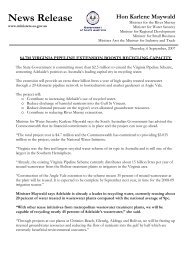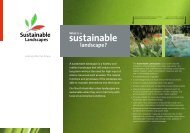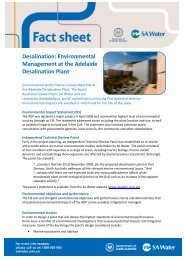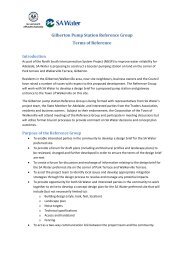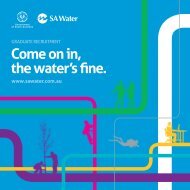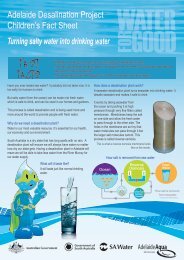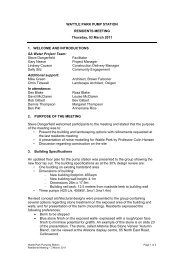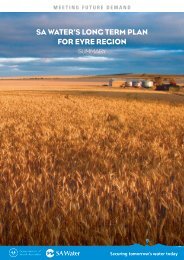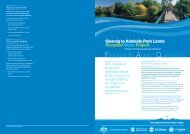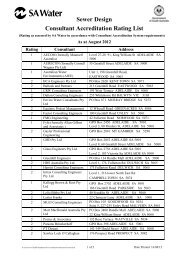Code of Practice - Irrigated Public Open Space - SA Water
Code of Practice - Irrigated Public Open Space - SA Water
Code of Practice - Irrigated Public Open Space - SA Water
You also want an ePaper? Increase the reach of your titles
YUMPU automatically turns print PDFs into web optimized ePapers that Google loves.
It was found that current practices were not resulting in<br />
excessive leaching or movement <strong>of</strong> water beyond the turf<br />
root zone and in fact, the principles applied to irrigation<br />
scheduling for couch areas (fairways, tees) was resulting in<br />
deficit irrigation against ET and still producing high<br />
quality surfaces.<br />
Through the latter part <strong>of</strong> the 2006-07 irrigation season one<br />
site was managed based on the data supplied from the soil<br />
moisture sensors and visual observations <strong>of</strong> turf quality. By<br />
autumn <strong>of</strong> 2007, irrigation management and lack <strong>of</strong> rainfall<br />
resulted in Volumetric Soil Moisture (VSM) being as low as<br />
1-2% without seriously compromising playing surface<br />
quality, although presentation was slightly reduced.<br />
This exercise highlighted the potential to make further<br />
reductions in water consumption.<br />
There is still much to learn about this technology in turf<br />
situations, but it has great potential, including the<br />
following:<br />
• Understanding the fate <strong>of</strong> applied water.<br />
• Understanding the impacts <strong>of</strong> irrigation practices.<br />
• Understanding the impacts <strong>of</strong> turf management practices.<br />
• Reduction in water consumption based on actual data<br />
and plant requirement knowledge.<br />
• Management <strong>of</strong> salinity.<br />
• Monitoring <strong>of</strong> nutrient and pesticide fate.<br />
• Timing <strong>of</strong> turf management practices and applications.<br />
APPENDICES<br />
44<br />
<strong>Water</strong> Supply<br />
Up until 1973 Glenelg Golf Club’s irrigation needs were<br />
supplied exclusively by bore water. The introduction <strong>of</strong> the<br />
automatic irrigation system in 1973 coincided with the<br />
introduction <strong>of</strong> recycled Class B effluent from the Glenelg<br />
Wastewater Treatment Plant, with demand being met for<br />
the next 30 years through a “50/50” blend <strong>of</strong> both bore and<br />
effluent water.<br />
Both water sources were <strong>of</strong> similar salinity (1000-1300ppm),<br />
with the effluent containing nutrient loading that was far<br />
from balanced with turf needs and had to be factored into<br />
fertility programming.<br />
In 2005, Glenelg Golf Club was faced with a choice for<br />
securing a longer term higher quality water supply due to<br />
price increases in the supply <strong>of</strong> effluent. The Club was very<br />
mindful <strong>of</strong> its obligation to have a positive impact on the<br />
wider community as well as to its members.<br />
Detailed investigations led to the decision to invest in a<br />
$2 million Aquifer Storage and Recharge project, which will<br />
see the diversion <strong>of</strong> stormwater from Brownhill Creek into<br />
newly constructed wetlands on the course. This stormwater,<br />
which would otherwise flow untreated into the Patawolonga<br />
and Gulf St Vincent, will be pumped into the wetlands<br />
where the water quality will be improved naturally by the<br />
plants before it is injected into the underlying aquifer.<br />
The resulting superior water quality (projected to be<br />
approximately 600ppm) will potentially result in further<br />
water savings due to improved reactions within the soil<br />
once applied.<br />
Summary<br />
Glenelg Golf Club is committed to sustainable management<br />
<strong>of</strong> water, and has invested heavily to develop and monitor<br />
efficiency improvements.<br />
This case demonstrates this commitment, which is<br />
documented throughout the Club’s Environmental<br />
Management System and Quality Turf Plan.<br />
FURTHER INFORMATION:<br />
Daryl Sellar, Consulting Superintendent<br />
Turfwise Consulting<br />
Glenelg Golf Course



